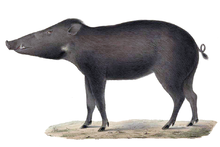Celebes warty pig
| Sulawesi warty pig | |
|---|---|

| |
| Illustration | |
| Scientific classification | |
| Domain: | Eukaryota |
| Kingdom: | Animalia |
| Phylum: | Chordata |
| Class: | Mammalia |
| Order: | Artiodactyla |
| Family: | Suidae |
| Genus: | Sus |
| Species: | S. celebensis
|
| Binomial name | |
| Sus celebensis | |
| Subspecies | |
| |
| Synonyms | |
|
Verrucophorus celebensis | |
The Celebes warty pig (Sus celebensis), also called Sulawesi warty pig or Sulawesi pig, is a species in the pig genus (
Description
The Celebes warty pig is a medium-sized pig, and quite variable in size and appearance. Although a number of subspecies have been recognised, it is now regarded as a monotypic taxon. It is the only pig species that has been domesticated apart from the wild boar; being semi-domesticated may have had an influence on the variability of its appearance.[2] This pig has a head-and-body length of between 80 and 130 cm (30 and 50 in) and a long tail, with males generally being larger than females. The back is rounded and the legs short. The colour is greyish-black, sometimes tinged with red or yellow on the flanks. There are three pairs of facial warts and a fringe of pale bristles on the snout and more bristles on the cheeks. The crown and nape are topped by a short crest of dark bristles, while a dark mid-dorsal stripe extends from the crest towards the tufted tail.[3] Young pigs have longitudinal stripes, but these fade as the piglets grow.[2]
Distribution and habitat
The Celebes warty pig occurs in Sulawesi, being plentiful in central, eastern and south-eastern parts of the island but uncommon in the northeastern and southern parts.
Ecology
This pig tends to move around in small groups of up to nine individuals, led by a dominant male and including several females and their offspring. Foraging takes place mainly in the early morning and the evening; the diet consists mainly of roots, shoots, leaves and fallen fruit, but also includes carrion, invertebrates and small vertebrates. Breeding takes place throughout the year. Gestation periods are probably between four and five months, and litter sizes can be up to eight, but in one study, averaged about two.[2] The most important natural predator is the reticulated python.[1]
Conservation status
The chief threats faced by this pig are an
Cave art
A
Geology
At one point in time there may have been a portion of the land which shifted upward resulted in increased diversification. The researchers found out that the Sulawesi who roam the island today were preceded by other ancestors who once expanded from the innermost area of the island to the outermost part of it.
References
- ^ . Retrieved 11 November 2021.
- ^ ISBN 978-2-8317-0141-7.
- ^ Huffman, Brent (18 February 2017). "Sus celebensis: Sulawesi Warty Pig". Retrieved 9 September 2019.
- PMID 33523879.
- ^ Agence France-Presse (13 January 2021). "World's oldest known cave painting found in Indonesia". The Guardian. Retrieved 13 January 2021.
Frantz, L., Rudzinski, A., Nugraha, A., Evin, A., Burton, J., Hulme-Beaman, A., Linderholm, A., Barnett, R., Vega, R., Irving-Pease, E. K., Haile, J., Allen, R., Leus, K., Shephard, J., Hillyer, M., Gillemot, S., van den Hurk, J., Ogle, S., Atofanei, C., Thomas, M. G., ... Larson, G. (2018). Synchronous diversification of Sulawesi's iconic artiodactyls driven by recent geological events. Proceedings. Biological sciences, 285(1876), 20172566. https://doi.org/10.1098/rspb.2017.2566
External links
 Media related to Sus celebensis at Wikimedia Commons
Media related to Sus celebensis at Wikimedia Commons Data related to Sus celebensis at Wikispecies
Data related to Sus celebensis at Wikispecies- The Ultimate Ungulate's entry on Sus celebensis

